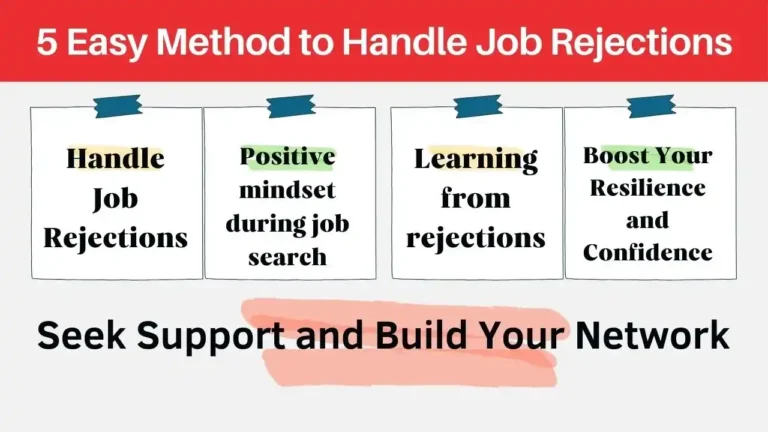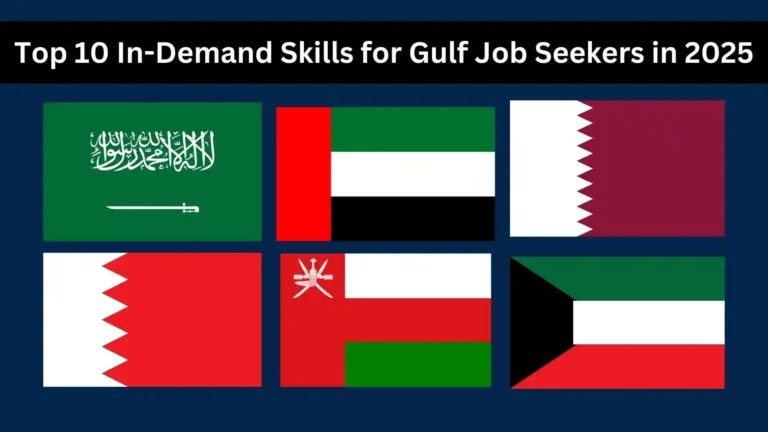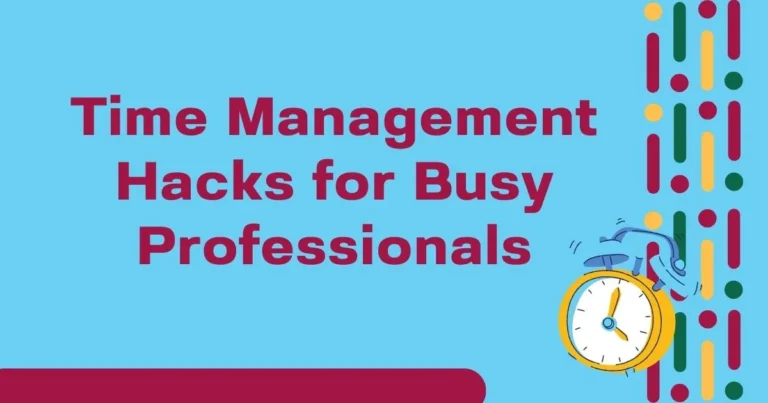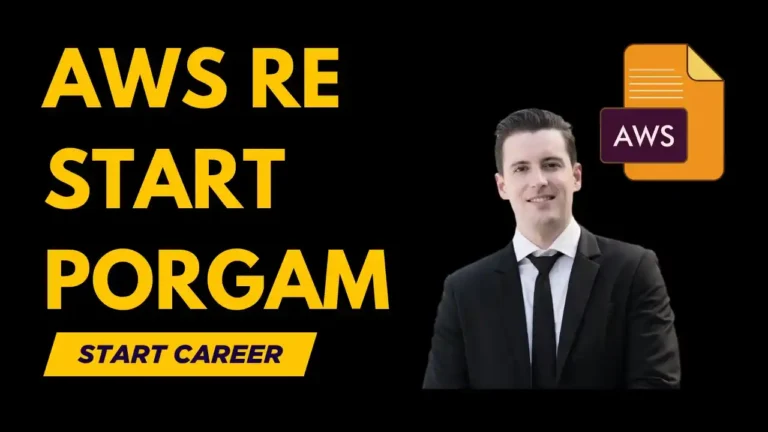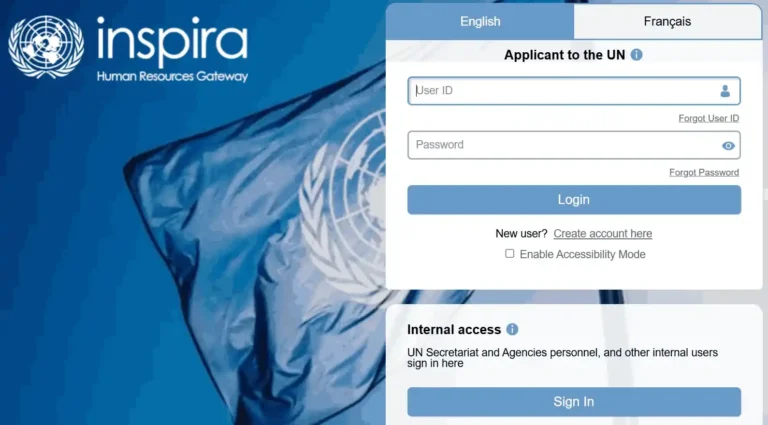In today’s competitive job market, having a well-established personal brand can set you apart from other job seekers. Gone are the days when only celebrities or large corporations focused on branding. Now, job seekers can harness personal branding to showcase their expertise, values, and unique selling points. Building a personal brand doesn’t happen overnight—it requires a strategic approach and continuous effort. However, when done right, it can significantly enhance your chances of landing your dream job.
A strong personal brand for job search success is very important as it helps potential employers see you as an expert in your field and ensures your online and offline presence align with the professional image you want to project.
In this guide, we’ll explore five actionable steps you can take to build a powerful personal brand for job search success. Whether you’re a recent graduate or a seasoned professional, these tips will help you attract the right job opportunities and establish yourself as an industry expert.
We will also discuss the advantages and potential challenges of this strategy and differentiate between Personal Brand for Job Search Success and Professional Portfolio also.
Table of Contents
Differentiate between Personal Brand for Job Search Success and Professional Portfolio
Both a personal brand and a professional portfolio are essential for career growth, but they serve distinct purposes. Here’s how they differ:
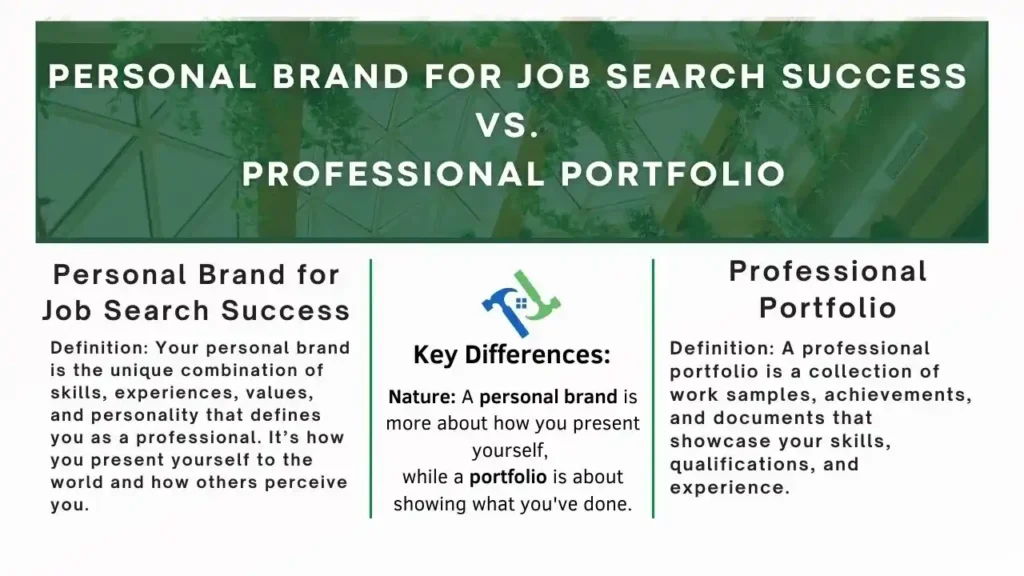
1. Personal Brand for Job Search Success
- Definition: Your personal brand is the unique combination of skills, experiences, values, and personality that defines you as a professional. It’s how you present yourself to the world and how others perceive you.
- Purpose: It helps you stand out in the job market, making you memorable and attractive to potential employers. Your personal brand tells your story, communicates your strengths, and shows how you can add value.
- How It Works:
- Focuses on visibility: Through networking, social media presence (LinkedIn, Twitter, etc.), and personal interactions.
- Considers reputation: What do people say about you? How do they perceive your work ethic, expertise, and personality?
- Builds a narrative: Telling your story in a compelling way, including your values, goals, and the type of work you’re passionate about.
- Online Presence: Consistent with your resume, LinkedIn profile, and personal website/blog.
2. Professional Portfolio
- Definition: A professional portfolio is a collection of work samples, achievements, and documents that showcase your skills, qualifications, and experience.
- Purpose: It serves as a tangible or digital proof of your capabilities, demonstrating your qualifications for specific roles and industries. It’s particularly useful in creative and technical fields.
- How It Works:
- Focuses on demonstration: Contains specific examples of your work, such as designs, projects, articles, code, presentations, or any work relevant to your industry.
- Evidence-based: Tangible proof of what you’ve accomplished, showing your skills in action.
- Format: Often includes PDFs, links to websites, or even a physical binder, depending on your profession. A digital portfolio may also include links to relevant projects on platforms like GitHub or Behance.
- Organized: The portfolio should be clear, organized, and easy to navigate, often customized for different job applications or industries.
Key Differences:
- Nature: A personal brand is more about how you present yourself, while a portfolio is about showing what you’ve done.
- Focus: Your personal brand is focused on perception and reputation, while a portfolio focuses on skills and work.
- Visibility vs Evidence: The personal brand makes you visible and known, while the portfolio provides the evidence that supports your claims of expertise.
- Format: Your personal brand is often communicated through social media, networking, and your personal narrative, while a portfolio is a more formal compilation of your work.
In summary, your personal brand helps you get noticed, and your professional portfolio helps you prove that you can deliver. Both work together to build credibility and support your job search efforts.
Now we will dive deeper to understand personal brand for job search success with more details.
Personal Brand for Job Search Success
What is a Personal Brand and Why Does it Matter for Job Seekers?
Recruiters and hiring managers want to see more than just a resume—they want to know who you are as a professional, how you contribute to the industry, and what makes you unique. This is where personal branding comes into play.
Your personal brand is a combination of your skills, experience, values, and how you present yourself both online and offline. A well-crafted personal brand not only sets you apart from other job seekers but also allows you to build credibility and trust within your industry.
1. Define Your Unique Value Proposition
Your unique value proposition (UVP) is what differentiates you from other candidates. It’s the answer to the question: “Why should an employer choose you?” Defining this clearly is crucial in building a solid personal brand.
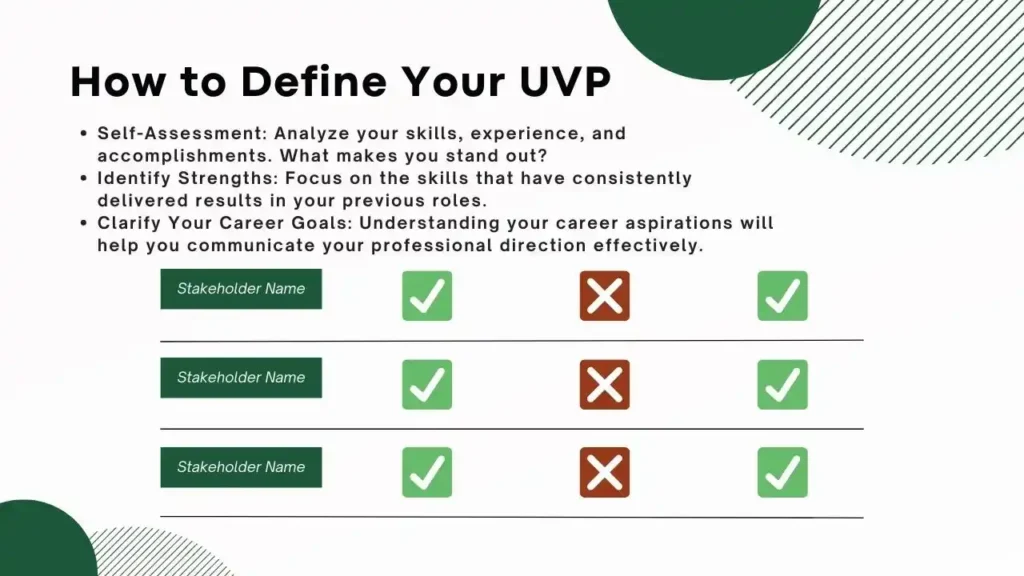
How to Define Your UVP
- Self-Assessment: Analyze your skills, experience, and accomplishments. What makes you stand out?
- Identify Strengths: Focus on the skills that have consistently delivered results in your previous roles.
- Clarify Your Career Goals: Understanding your career aspirations will help you communicate your professional direction effectively.
Tip: Incorporate your UVP into your resume, LinkedIn profile, and networking pitches. Doing this consistently will solidify your brand.
Pros:
- Highlights your strengths
- Helps employers understand your unique qualities
Cons:
- Can be challenging to identify initially
- Requires frequent updates as you grow professionally
Example UVP:
“I help companies streamline their IT operations by implementing scalable and secure cloud solutions.”
2. Optimize Your Online Presence
In the digital age, your online presence is often the first impression employers have of you. Ensure it aligns with the brand image you want to project.
Key Steps to Improve Your Digital Footprint
- LinkedIn Optimization: Keep your profile up-to-date, craft a compelling summary, and engage by posting industry-relevant content.
- Social Media Audit: Remove or hide any content that doesn’t align with your professional image.
- Personal Website: If possible, create a website showcasing your portfolio, achievements, and career journey.
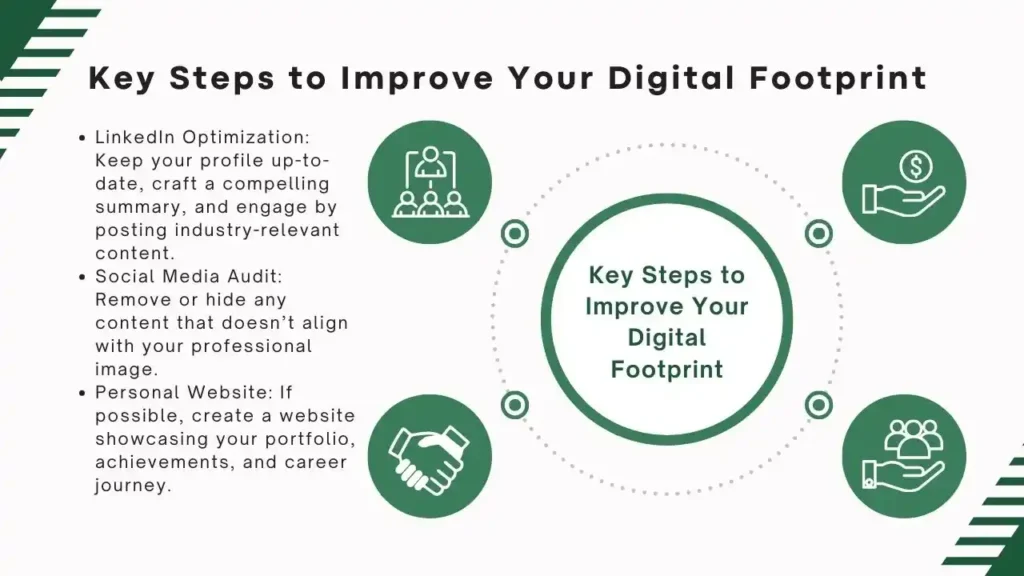
Pros:
- Increases your visibility in the job market
- Positions you as a thought leader
Cons:
- Maintaining an updated presence requires consistent effort
- Social media mishaps can harm your reputation
Pro Tip: Consistency is key. Use the same professional photo and tone of voice across all platforms.
3. Create and Share Valuable Content
One of the best ways to build your brand is by sharing your knowledge and insights with others.

Content Creation Ideas
- Blog Posts: Write about your field of expertise and career experiences.
- Videos or Webinars: Share instructional content or career advice.
- Social Media Updates: Post engaging content on LinkedIn and Twitter that reflects your personal and professional values.
Why This Works: When you share valuable content, you position yourself as an expert and thought leader, which makes you more attractive to potential employers.
Pros:
- Builds your credibility in the industry
- Helps with networking and connections
Cons:
- Requires creativity and time investment
- Not everyone is comfortable with content creation
Build an Engaging Portfolio Website
Why You Need a Portfolio Website for Job Search Success
A portfolio website serves as a central hub for your professional content. It allows employers to easily access your work, read about your achievements, and get in touch.
Key Elements of a Portfolio Website:
- Homepage: Include a captivating introduction and a clear navigation menu.
- About Me: Share your career story, key milestones, and values.
- Portfolio: Showcase your best work, including projects, case studies, and testimonials.
- Contact Information: Provide multiple ways for potential employers to reach you.
Pro Tip: Use SEO best practices to optimize your portfolio site for relevant keywords.
4. Network Strategically
Why Networking is Essential for Job Search Success
Networking is a crucial part of personal branding. Building meaningful connections can open doors to job opportunities and industry insights.
Networking Tips
- Attend Events: Participate in both virtual and in-person events related to your industry.
- Leverage Social Media: Join professional groups and engage in conversations.
- Offer Value: Focus on helping others rather than just seeking opportunities.
Pros:
- Expands your professional circle
- Keeps you informed about industry trends
Cons:
- Can be time-consuming
- Requires confidence and communication skills
Pro Tip: Maintain relationships by staying in touch and providing value to your network.
5. Seek Testimonials and Endorsements
Nothing validates your skills better than endorsements from colleagues, supervisors, and clients.
How to Gather Testimonials
- Ask for Recommendations: Request recommendations from previous employers or colleagues on LinkedIn.
- Client Feedback: If you’ve worked as a freelancer (like myself on fiverr.com with profile Israr Ahmed), showcase client reviews.
- Display Them: Use testimonials on your website, portfolio, or social profiles.
Pros:
- Builds trust and credibility
- Provides social proof of your skills
Cons:
- Requires effort to collect
- Not all testimonials may be impactful
Key Takeaways
- Personal branding is essential for standing out in the job market.
- Define your unique value proposition to differentiate yourself.
- Maintain an optimized and professional online presence.
- Share valuable content to position yourself as a thought leader.
- Networking strategically can lead to new job opportunities.
- Seek and display testimonials for added credibility.
1. Building Social Proof for Personal Branding
Positive testimonials and endorsements from colleagues can significantly enhance your credibility.
2. Creating a Visual Identity for Your Brand
Use consistent colors, fonts, and profile photos across platforms for a cohesive brand image.
3. Crafting an Elevator Pitch for Networking Events
A well-crafted elevator pitch can make a lasting impression during networking events.
4. Tracking the Performance of Your Personal Brand
Use analytics tools to measure engagement and track the success of your content.
5. Leveraging Recommendations to Boost Your Brand
Encourage colleagues and clients to leave recommendations on LinkedIn or your portfolio site.
Read Also: How to Build a Winning Resume for Fresh Graduates: 8 Step-by-Step Guide
FAQs on Personal Brand for Job Search Success
Why is personal branding important for job seekers?
Personal branding is essential because it helps you stand out in a competitive job market. It showcases your unique skills, values, and experiences, allowing employers to quickly understand who you are and what you bring to the table. A strong brand builds trust, credibility, and makes you more memorable during the hiring process.
How can I identify my unique value proposition?
To find your unique value proposition, reflect on your:
Key strengths and skills
Professional accomplishments
Career aspirations
Feedback from peers or mentors
This combination helps define what sets you apart and how you can uniquely solve problems or add value to a company.
Is it necessary to have a personal website?
While not mandatory, a personal website significantly boosts your online visibility and credibility. It serves as a centralized platform to showcase your portfolio, resume, testimonials, and personal brand story—especially helpful for creatives, consultants, and freelancers.
How often should I update my LinkedIn profile?
Update your LinkedIn profile at least once every 3–4 months, or whenever you:
Complete a new project
Start or leave a job
Earn a certification
Publish a noteworthy article
Frequent updates signal activity and relevance to recruiters.
What kind of content should I share to build my brand?
Share content that reinforces your expertise and interests, such as:
Blog posts or articles
Case studies or project highlights
Industry trends or insights
Thoughtful comments on relevant topics
Consistency and authenticity in your content help build trust and authority in your niche.
How can I network effectively if I’m introverted?
If you’re introverted, focus on one-on-one connections, virtual networking, and asynchronous communication like LinkedIn messaging or email. Attend webinars or niche online communities where interactions feel more comfortable. Remember, quality connections matter more than quantity.
What should I avoid when building my personal brand?
Avoid:
Inconsistency in your messaging across platforms
Unprofessional content or behavior online
Overexaggerating achievements
Neglecting your online presence
Your personal brand should be authentic, consistent, and aligned with your goals.
How can testimonials help in personal branding?
Testimonials act as social proof, showcasing your strengths through the eyes of others. Endorsements from clients, colleagues, or managers build credibility and trust, especially when posted on your LinkedIn profile, website, or portfolio.
Can personal branding help me switch industries?
Yes! A strong personal brand highlights your transferable skills and positions you as a valuable candidate—even in a new industry. By focusing on your adaptability, accomplishments, and problem-solving abilities, you can bridge the gap between your current and target roles.
How long does it take to build a strong personal brand?
Building a personal brand is an ongoing journey. While some visibility can be gained in a few weeks with consistent effort, establishing a strong, recognizable brand typically takes several months to a year. The key is to stay consistent, authentic, and focused.
Conclusion
Building a personal brand for job search success requires time, effort, and strategic planning. By defining your unique value proposition, optimizing your online presence, sharing valuable content, networking strategically, and gathering testimonials, you can position yourself as a top candidate in your industry.
Remember, consistency and authenticity are key to long-term success. Start today, and watch your personal brand work wonders for your career.
What are your thoughts or personal experiences in building a personal brand? Share in the comments below!








